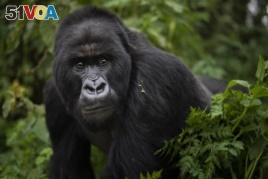03 November, 2019
Pato, a 19-year-old silverback gorilla, walked using his arms and legs toward an infant gorilla, Macibiri.
Pato sat beside her and ran his long fingers through her fur.
He was looking for insects or other things caught in her shiny black coat. He made a low hum.
"Not every silverback will do that, will pay attention to the infants," says biologist Jean Paul Hirwa. "That shows his personality. Pato is one chill silverback."
Hirwa made the comment in the forests of Rwanda's Volcanoes National Park while speaking to reporters from the Associated Press. He works for the Dian Fossey Gorilla Fund, a conservation nonprofit group.

In this Sept. 2, 2019 photo, a silverback mountain gorilla named Segasira walks in the Volcanoes National Park, Rwanda. A concerted and sustained conservation campaign has averted the worst and given a second chance to these great apes, which share about 98% of human DNA. (AP Photo/Felipe Dana)
Fossey, who died in 1985, would likely be surprised that there are any mountain gorillas left at all. Alarmed by rising rates of poaching and deforestation in central Africa, she predicted the animals could disappear by 2000.
Instead, a conservation campaign has given a second chance to these great apes, which share about 98 percent of their DNA with humans.
Increase in numbers
Last fall, the Switzerland-based International Union for Conservation of Nature changed the threat level of mountain gorillas from "critically endangered" to "endangered."
It would not have happened without efforts that some biologists call "extreme conservation."
Extreme conservation involves monitoring every single gorilla in the rainforest and sometimes giving them veterinary care — to clean infected wounds, for example.
It also involves paying for forest protection by sending money into communities that might otherwise want to turn the forests into croplands.
The number of mountain gorillas has risen from 680 a decade ago to just over 1,000 today. Their population is split between two areas, including volcanoes within Congo, Uganda and Rwanda.
"The population of mountain gorillas is still vulnerable," says George Schaller, a biologist and gorilla expert. "But their numbers are now growing, and that's remarkable."
Emergency medicine
Back in the forests of Volcanoes National Park, Hirwa noticed a wound on Pato's chest.
Most likely, he guessed, Pato had been struggling with the family's second silverback for control of the group.
Later, Hirwa reported the wound to the park chief and workers at Gorilla Doctors, a nongovernmental group whose veterinarians work in the forest.
The animal doctors watch for wounds and signs of lung infections, but they do not intervene often.
When they do — for example, by giving a gorilla antibiotic drugs — they almost never remove the animals from the mountain. Reuniting gorillas can be difficult.
"Our hospital is the forest," says Jean Bosco Noheli, a veterinarian with Gorilla Doctors. When his team goes into the field for a gorilla emergency, they must carry everything they might need in equipment bags weighing up to 100 pounds — including portable X-ray machines.
Tours and giving back to the community
Today, highly regulated groups hike in the Rwandan rainforest to see the gorillas.
Within Volcanoes National Park, groups are limited to eight people at a time, with only an hour spent watching gorillas.
The groups cannot carry food or even water bottles near the animals. The reason: a silverback could take the objects and perhaps be exposed to germs.
Guides tell visitors not to hold eye contact with the gorillas for too long. And if a gorilla acts aggressively — which is rare — visitors are supposed to look down and bend their knees. Hirwa calls this the "submissive pose."
The number of tourists each day is limited, and the price is high: $1,500 per visit.
"With tourism, the tension is always not to overexploit," says Dirck Byler. He is great ape conservation director at the nonprofit Global Wildlife Conservation. The group is not involved in the Rwanda gorilla project. Byler said, "In Rwanda, so far they're careful, and it's working."
In 2005, the Rwandan government adopted a plan to take five percent of tourism income from Volcanoes National Park. It used the money to help surrounding villages. Two years ago, that number increased to 10 percent.
So far, about $2 million has gone into paying for village projects, chief park warden Prosper Uwingeli says. "Every year, we meet with the communities," he says. "We have to give back."
I'm John Russell. And I'm Ashley Thompson.
Christina Larson reported on this story for the Associated Press. John Russell adapted it for Learning English. Mario Ritter Jr. was the editor.
________________________________________________________________
Words in This Story
hum – n. a low continuous sound
chill – adj. informal : relaxed
poaching – n. the act of hunting or fish illegally
critically – adv. medical relating to or involving great danger of death
vulnerable –adj. able to be harmed, at risk
monitor – v. to watch, observe, listen to, or check (something) for a special purpose over a period of time
reunite – v. to bring (people or things) together again especially after they have been apart for a long time
regulate – v. to control or supervise something
submissive – adj. willing to obey someone else
We want to hear from you. Write to us in the Comments Section.